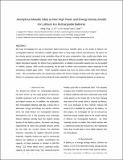| dc.contributor.author | Meng, Shirley Y. | |
| dc.contributor.author | Li, Yi | |
| dc.contributor.author | Arroyo, Elena M. | |
| dc.contributor.author | Ceder, Gerbrand | |
| dc.date.accessioned | 2003-12-20T18:55:57Z | |
| dc.date.available | 2003-12-20T18:55:57Z | |
| dc.date.issued | 2002-01 | |
| dc.identifier.uri | http://hdl.handle.net/1721.1/3966 | |
| dc.description.abstract | We have investigated the use of aluminum based amorphous metallic glass as the anode in lithium ion rechargeable batteries. Amorphous metallic glasses have no long-range ordered microstructure; the atoms are less closely packed compared to the crystalline alloys of the same compositions; they usually have higher ionic conductivity than crystalline materials, which make rapid lithium diffusion possible. Many metallic systems have higher theoretical capacity for lithium than graphite/carbon; in addition irreversible capacity loss can be avoided in metallic systems. With careful processing, we are able to obtain nano-crystalline phases dispersed in the amorphous metallic glass matrix. These crystalline regions may form the active centers with which lithium reacts. The surrounding matrix can respond very well to the volume changes as these nano-size regions take up lithium. A comparison study of various kinds of anode materials for lithium rechargeable batteries is carried out. | en |
| dc.description.sponsorship | Singapore-MIT Alliance (SMA) | en |
| dc.format.extent | 295398 bytes | |
| dc.format.mimetype | application/pdf | |
| dc.language.iso | en_US | |
| dc.relation.ispartofseries | Advanced Materials for Micro- and Nano-Systems (AMMNS); | |
| dc.subject | amorphous aluminum based metallic glass | en |
| dc.subject | lithium ion rechargeable batteries | en |
| dc.subject | high power and energy density anodes | en |
| dc.title | Amorphous Metallic Glass as New High Power and Energy Density Anodes For Lithium Ion Rechargeable Batteries | en |
| dc.type | Article | en |
